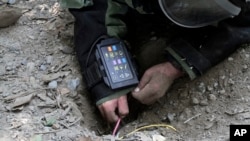Mohammad Nasir Atmar was at home one day in August when he heard a huge explosion and saw plumes of black smoke outside his window in the Macroryan area of Kabul city. It was a moment of terror.
"I went down to see if any help was needed at the scene," he said, "as there were a lot of civilian casualties.”
The attack happened in a residential area built by the Soviets, killing 12 people and injuring 66 others.
It was carried out by a vehicle-borne improvised explosive device, a type of IED that is used by insurgents to target the Afghan National Security Forces and their NATO counterparts but often affects innocent civilians.
Ordinary Afghans are bearing most of the brunt of the current conflict, which is in its 15th year.
Nicholas Haysom, the U.N. secretary-general’s special representative and head of the U.N.'s assistance mission in Afghanistan, said in a report in August that Afghans had suffered a lot and that it was time for the violence to end.
“Afghan civilians have suffered far too long from this destructive conflict," he said. "The devastating consequences of this violence against civilians as documented in this report should serve to strengthen the broad conviction that peace is urgently needed.”
Development deterred
The Taliban are active across Afghanistan but are most visible in the country’s south and east. Local and international organizations are reluctant to implement development projects in areas where the Taliban have a powerful presence, fearing attacks and roadside bombs.
Shahab Hakimi, director of the nongovernmental Mine Detection Dog Center in Afghanistan, said IEDs are a hurdle for development in in the country. Last Thursday, he said, "two engineers who wanted to go and help build a clinic in Charkh district of Maidan Wardak province drove over an IED and died. The project was postponed after the incident.”
A resident of the Shajoy district of Zabul province who did not want to be named for security reasons told VOA that a lot of bridges have been blown up on the Kabul-Kandahar highway by the insurgents and that noncombatants suffer as a result, especially during the flooding season.
According to the U.N. report released last month, in the first half of this year alone, more than 4,900 civilian casualties have been documented — nearly 1,600 deaths and about 3,300 wounded. Nearly the same number of people were also killed and injured during the same period in 2014.
According to the report, 90 percent of the civilian casualties resulted from ground engagements, with IEDs as the second leading cause of civilian deaths after targeted killings.
Blind weapons
IEDs are blind weapons that target innocent civilians indiscriminately, said Mohammad Sediq Rashid, director of the Mine Action Coordination Center of Afghanistan, which organizes demining efforts in the country.
“IEDs continue to target innocent civilians," he said. "Every month, nearly 100 innocent people are killed and injured by IEDs across Afghanistan.” There have been dozens of incidents across the country in which buses carrying civilians drove over roadside bombs and were blown up, killing or injuring innocent people.
Alizai, a resident of southern Helmand province, told VOA that he and his family live in constant fear because of IEDs. According to Alizai, IEDs are planted indiscriminately, and only a few insurgents are in charge of them.
“[And when the insurgents die] in airstrikes or during battles with Afghan National Security Forces, no one knows where they planted their IEDs," he said. "This made life hellish for ordinary Afghans as they fear traveling on roads.”
Afghanistan once was at the top of the list of countries that have the most unexploded ordnance and mines. The mine detection center's Hakimi said that because a lot of the ordinance had been cleared away, donor countries have reduced their aid for the work He said, however, that IEDs are going to be a continuing problem for Afghanistan, since it has been cleared only of mines that were planted in previous wars and unexploded ordinance left over from various warring factions.
Editor's note: An earlier version of this story said a UN Report indicated that IEDs contribute to 90 percent of the civilian casualties in Afghanistan. The report actually said 90 percent of civilian casualties resulted from ground engagements, and IEDs are the second leading cause of civilian deaths after targeted killings.










